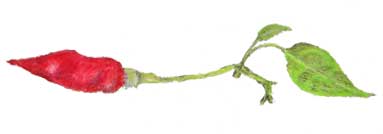
Family • Solanacea
| Sili, genus capsicum, is known in several varieties: Capsicum annum (Sili); Capsicum annuum var. longum (Siling-haba); Capsicum annuum (Siling-bilog, Siling-lara); Capsicum fructescens (Siling-labuyo). | ||
| Sili |
Siling-haba |
Siling-bilog |
| Capsicum annuum | Capsicum annuum var. longum | Capsicum annuum var. grossum |
| Other scientific
names C. chamaexcerasus C. grossum Capsicum tetragonum |
Other scientific
names C. annuum var. longum Sendt. |
|
| Common names Kalubengan (Bon.) kalubsengan (Bon.) Sile (Tag.) Sili (Tag., Ilk, Bik.) Sileng bilog (Tag.) Green pepper, pepper (Engl.) |
Common names Sileng-haba (Tag.) Sileng mahahaba (Tag.) Long pepper (Engl.) Spanish pepper (Engl.) A A |
Common names Sileng-bilog (Tag.) Rounded pepper (Engl.) a a a |
| Description Erect, branched, smooth, annual herb, 30-50 cms long, pointed at both ends. Flowers are solitary and axillary, 1 to 1.8 cm in diameter. Petals are white to straw-colored. Fruit is of various sizes and varieties. |
Description Fruit is greenish-yellow or red, oblong lanceolate, narrowing to a tapering tip, up to 6 cm long and 1.5 cm across. It is spicy hot, often used in local pickles (achara) and for seasoning. |
Description |
| Sili, genus capsicum, is known in several varieties: Capsicum annum (Sili); Capsicum annuum var. longum (Siling-haba); Capsicum annuum (Siling-bilog, Siling-lara); Capsicum fructescens (Siling-labuyo). | ||
| Other vernacular names (Capsicum annuum L. var. grossum (L.) Sendt. |
| AFRIKAANS: Soet rissie. |
| ARABIC: Felfel roomy, Filfil halwah (Iraq). |
| CHINESE: Deng long jiao, Tian jiao, Shi tou fan jiao, Yuan tian jiao, Da la jiao, Qing jiao, Shi zi jiao. |
| CROATIAN: Paprika slatka. |
| DANISH: Soed capsicum. |
| DUTCH: Zoete peper. |
| FRENCH: Poivron, Poivron doux, Poivron d'Espagne, Piment doux. |
| GERMAN: Spanischer Pfeffer . |
| HEBREW: Pilpel matok. |
| HINDI: Shimlaa mirch. |
| HUNGARIAN: Paprika. |
| ITALIAN: Peperone dolce. |
| JAPANESE: Ama tougarashi, Shishi tougarashi, Beru peppaa, Piiman. |
| MALAY: Cabai manis, Lombok besar (Indonesia). Chili manis, Cili manis, Chili besar, Cabe besar, Lada besar (Malaysia). |
| NEPALESE: Bhede khursaanii. |
| NORWEGIAN: Grønn paprika. |
| PERSIAN: Dolmeh felfel. |
| PORTUGUESE: Pimento doce, Pimentao doce, Pimentão doce (Brazil). |
| ROMANIAN: Ardei gras, Ardei lung, Ardei de boia. |
| SLOVENIAN: Sladka paprika. |
| SPANISH: Chili dulce, Pimiento dulce, Chile dulce, Chile morrón (Mexico). |
| THAI: Phrik yak. |
| URDU: Shimlaa mirch. |






